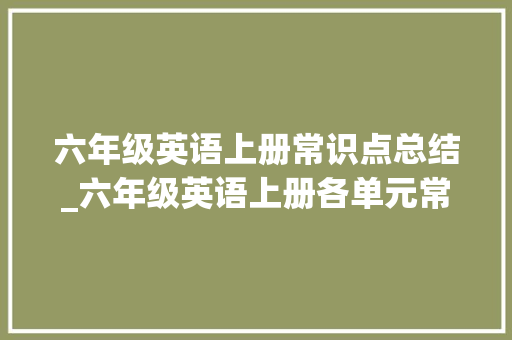
重点短语:
by plane 坐飞机 by ship 坐轮船 on foot步辇儿 by bike 骑自行车
by bus 坐公共汽车 by train 坐火车 traffic lights 交通灯
traffic rules交通规则 go to school 去上学 get to 到达
get on上车 get off下车 Stop at a red light. 红灯停
Wait at a yellow light. 黄灯等 Go at a green light. 绿灯行
重点句型:
1.How do you go to school? 你怎么去上学?
2.Usually I go to school on foot. Sometimes I go by bus.
常日我步辇儿去上学。有时候骑自行车去。
3.How can I get to Zhongshan Park ? 我怎么到达中山公园?
4.You can go by the No. 15 bus. 你可以坐15路公共汽车去。
重点语法:
1、There are many ways to go somewhere.到一个地方去有许多方法。 这里的ways一定要用复数。由于there are是There be句型的复数形式。
2、on foot 步辇儿 乘坐其他交通工具大都可以用介词by…, 但是步辇儿只能用介词on 。
3、go to school的前面绝对不能加the,这里是固定搭配。
4、USA 和 US 都是美国的意思。其余America也是美国的意思。
5、go to the park 前面一定要加the. 如果要去的地方有详细的名字,就不能再加the , 如果要去的地方没有详细名字,都要在前面加the. ( go to school除外。)
6、How do you go to …?你若何到达某个地方?如果要问的是第三人称单数,则要用:How does he/she…go to …?
7、反义词:
get on(上车)---get off(下车)near(近的)—far(远的)fast(快的)—slow(慢的)
because(由于)—why(为什么) same(相同的)—different(不同的)
8、近义词:
see you---goodbye sure---certainly---of course
9、频度副词:
always 总是,一贯 usually 常日 often常常 sometimes 有时候 never 从来不
Unit 2 Where is the science museum?一、重点短语:
library 图书馆 post office 邮局 hospital医院 cinema 电影院 bookstore书店
science museum科学博物馆 turn left向左转turn right 向右转 go straight直行
north北 south南 east东 west西 next to靠近、与……。相邻 then 然后
二、重点句型:
1.Where is the cinema, please? 叨教电影院在哪里?
2.It’s next to the hospital. 它与医院相邻。
3.Turn left at the cinema, then go straight. It’s on the left.
在电影院向左转,然后直行。它在左边。
三、重点语法:
1、问路时要用\"大众excuse me对不起,打扰一下\公众
2、描述路时可以用顺序词: first首先, next接着, then然后
3、near 表示在附近,next to 表示与…相邻。它的范围比near小。
in front of 在。。。前面 behind 在……后面
4、在左边,在右边介词要用on, on the left/on the right,但是东西南北,介词要用in, in the north/east/south/west.
5、for 表示持续多永劫光,当表示做某事多永劫光都要用for.? 如:Walk east for 5 minutes.? Then walk straight for three minutes.
6、乘几路车可以用by the No.301 bus, 把稳No.中N要大写,后面要加点。如果要用动词可以用take,例如take the No.301 bus.
7、当表示某个地方在另一个地方的哪一方向时,要用介词of。如:the hospital is east of the cinema. 医院在电影院的东边。
8、表示在哪儿转时,用介词at。 如:Turn left at the bank。在银行左转。
9、find表示\"大众找到\公众,强调找的结果。Look for 表示\"大众探求\公众,强调找的过程。
10、在几点前面要用介词at,如at 7p.m. 11、英文的书信与中文的书信不完备一样: 开头:英语是在人称后面加逗号,中文是加冒号。
正文:英语是空三个或者五个字母写,中文要空两个中笔墨格。
结尾:英语的题名与人名是顶格而且是分开写的。中文则是另起一行,放在一起且稍靠后一点儿的地方。英文名字的书写要把稳下。
12、近义词:
bookstore==bookshop 书店 go straight==go down直行
after school==after class 放学后
13、反义词或对应词:
here (这里)---there(那里) east(东)---west(西) north(北)---south(南) left(左)---right(右) get on (上车)---get off(下车)
14、in the front of…表示在…的前面,是指在该地方的范围内,in front of而则表示在该地方的范围外。如:in front of our classroom是指在教室的表面而且在教室的前面。而in the front of classroom则是指在教室里的前面。
15. be far from…表示离某地远。 be 可以是am , is ,are. My home is not far from school.我家离学校不远。
Unit 3 What are you going to do ?一、重点短语:
this morning 本日上午 this afternoon 今天下午 this evening 本日晚上
next week 下周 tomorrow 来日诰日 tonight 今晚 post card 明信片
comic book漫画书 newspaper报纸
二、重点句型:
1.What are you going to do on the weekend?你周末打算做什么?
2.I’m going to visit my grandparents this weekend?
这个周末我打算去看望我的外祖父母。
3.Where are you going this afternoon? 你今天下午打算去哪里?
4.I’m going to the bookstore.我打算去书店。
5.What are you going to buy?你打算去买什么?
6.I’m going to buy a comic book.我打算去买一本漫画书。
三、重点语法:
1、What are you going to do?你想做什么?讯问他人在未来的打算。be going to 后面要跟动词的原形。把稳be going to be 意思是 \公众打算成为什么,干什么职业。\公众把稳一下句子的差异,找出精确回答。What are you going to do this afternoon?What are you going to buy?What are you going to be?When are you going?Where are you going?How are you going?Who are you going with?
2、this evening 和 tonight的 差异:this evening指的是本日晚上睡觉以前的韶光,一样平常指晚上十二点以前。而tonight指的是今晚,一样平常是指一整晚的韶光,通宵。
3、部分疑问代词的意义与用法:
(1)What 什么。用来问是什么,做什么,叫什么,什么样等等。
如:What is your name? 你的名字叫什么?
What is your father? 你爸爸是干什么的?
What is your hobby?你的爱好是什么?
What is your favourite food?你最喜好的食品是什么?
What's your math teacher like? 你的数学老师长得什么样子?
(2)Where , 在哪里,到哪里。用来问地点。
如:Where are you from?你从哪里来?
Where are you going to ?你打算去哪里?
Where is my ruler?我的尺子在哪里?
(3)When,什么时候。用来问韶光。
如: When is your birthday? 你的生日是什么时候?
When are you going to ?你打算什么时候去?
When do you go to school?你什么时候去上学?
(4)what time 几点了。用来问详细的韶光,
如:What time is it? 现在几点了?
(5)What colour什么颜色。用来问物体的颜色。如: What colour is your schoolbag?你的书包是什么颜色的?
(6)What kind of 什么种类。用来问种别。
如 What kind of fruit do you like?你最喜好哪一种水果?
(7)who谁。用来问人物是谁。
如: Who is your English teacher ?你的英语老师是谁?
Who's that man? 那个男人是谁?
(8) whose谁的。用来问物体的主人是谁?
如: Whose pencil is this? 这是谁的铅笔?
Whose bike is blue? 谁的自行车是蓝色的?
(9) which哪一个。用来问详细的哪一个。
如: Which season do you like best?你最喜好哪个时令?
Which pencil is ken's? the long one or the short one?
哪只铅笔是Ken的?长的那支还是短的那支?
(10)how若何?用来问身体状况,或者事情的状况,对事宜的意见等。
如: How are you?你好吗?
How is your mother? 你妈妈好吗? How about you? 你呢?
(11)how many多少个。用来问有多少个,后面要跟名词的复数形式。
如: How many books do you have?你有多少本书?
How many kites can you see? 你能瞥见多少只鹞子?
(12)how much 多少钱。用来问物体的价钱。
如: How much are they? 他们多少钱?
How much is your schoolbag? 你的书包多少钱?
(13)how old 几岁了。用来问年事。
如 How old are you ? 你几岁了?
How old is your father? 你爸爸多大了?
(14)why为什么。用来问缘故原由,一样平常要用because来回答。
如:why do you like spring?你为什么喜好春天?
Because I can fly kites.国为我可以放鹞子。
(15) how long 多长
(16)how tall 多高
5、I want to be…我想成为… 表示空想。相称于I'm going to be ….
6、地点名称:fruit stand 水果店? clothes shop服装店? shoe store鞋店?
pet shop宠物店? theme park主题公园? the Great Wall长城? plant shop 植物店restaurant 饭店 bus stop 公交车站
7、在哪个门用介词at, at the north/east/south/west gate.
8、现在进行时与一样平常将来时的差异:
Unit 4 what are your hobbies?一、重点词汇:
hobby爱好 ride a bike骑自行车 dive跳水 play the violin拉小提琴 make kites制作鹞子 collect stamps集邮 live居住 teaches教 Watches不雅观看 goes去 does doesn’t=does not city 城市 county 国家或者村落庄 province 省
二、重点句型:
1.What’s your hobby? 你的爱好是什么?
2.I like collecting stamps. 我喜好集邮。
3.He likes collecting stamps, too.他也喜好集邮
4.Does she teach English? No, she doesn’t. 她教英语吗? 不。
5.Does she teach you math? Yes, she does.
她教你数学吗? 是的。
三、重点语法:
1、动词变为动名词的规则:
动词变为动名词,即是动词加ing。一样平常要遵照以下三条规则:
(1)一样平常情形下,在动词的后面直接加ing。如:play-playing read-reading do-doing go-going
(2)以不发音的字母e结尾的动词,要去掉不发音的字母e,再加ing。如:write-writing ride-riding make-making dance-dancing
(3)以单元音加票据音结尾的重读闭音节,要双写末了一个辅音字母,再加ing。
如run-running swim-swimming put-putting sit-sitting
2、记住like后面要加动词ing,说爱好有三种说法:①I like swimming.②Swimming is my hobby.③My hobby is swimming.
把稳:She likes drawing pictures, listening to music and making kites.这几个爱好是并列的,都是在like后面,以是都要加ing.
3、关于第三人称单数:
动词变为第三人称单数形式的规则:
(1)在一个句子中,如果主语人称既不是你,也不是我,而是其余的一个人,这时的人称叫做第三人称单数。
(2)在第三人称单词的句子中,动词要利用第三人称单词形式。
(3)动词变为第三人称单数形式,要遵照以下规则:
①一样平常情形下,在动词的后面直接加s。如: read--reads make-makes write-writes
②以字母s, x, o , sh , ch结尾的动词,在词尾加es。如:do-does wash-washe teach-teaches go-goes pass-passes
③以y结尾的动词分为两个情形,以元音字母加y结尾的动词,在词尾直接加s。如:play-plays buy--buys
以辅音字母加y结尾的动词,要把y变为i,再加es.如study--studies
④以f , fe结尾的名词,先把f,fe变为v,再加-es.
⑤分外变革:have--has
(4)在一个第三人称单数的句子中,只要句子中涌现了does或者其否定形式doesn't.该句子中的其他动词就要利用原形。
(5)第三人称单数切实其实定句在变为否定句时,在动词的前面加doesn't. 动词恢复原形。
如:He lives in Beijing.---He doesn't live in Beijing.
(6) 第三人称单数的陈述句在变为一样平常疑问句时,用does开头,后面的动词也要变为原形。
如:He lives in Beijing.---Does he live in Beijing?把稳:用来does,后面的动词就不能用第三人称形式。
3、把稳几个单词的变革:hobby(复数形式)-hobbies have to(同义词)-must same(反义词)---different look the same 看起来一样
Unit 5 What does he do?重点单词和短语
factory工厂 worker,工人postman,邮递员businessman贩子 police officer警察fisherman渔民 scientist,科学家pilot翱翔员 coach教练job事情think of考虑/有。。。想法go to work去事情 study hard努力学习 stay healthy保持康健 go home 回家 lots of许多 go to the camp去度假营 be good at善于。。。head teacher校长
do(三单) does work(三单) works he(主格) his(所有格) him(宾格)
she(主格) her(宾格或所有格) business(名词) businessman
fish(名词) fisher can (否定形式)can’t drive (名词)driver teach (名词)teacher country(复数)countries clean(名词)cleaner write (名词)writer sing(名词)singer
dancer (动词)dance player(动词) play worker(动词) work
is(否定形式) isn’t go(现在分词) going see(三单) sees
big (反义词)small tall (反义词)short thin(反义词) fat/strong
short (反义词)tall/long sea(同音词) see lots of =a lot of
has (原形)have healthy(名词) health life (动词)live
hard(反义词)easy stay(三单)stays study(三单)studies
science(名词)scientist university(复数) universities
those(反义词) these different (反义词)same
like(三单) likes go(三单) goes want(三单) wants
run(现在分词) running report (名词)reporter
use(现在分词) using quick (副词)quickly they(主格) them(宾格)
their(所有格) children (单数)child didn’t (否定形式)don’t /doesn’t
unusal (反义词)usual dangerous (反义词)safe farm(名词) farmer
test(名词) tester eat (现在分词)eating have(三单) has
1.What does he do? He’s a businessman. 这是一个讯问职业的句型, 它的构成是“ What do/ does+某(些)人+do?”, 可以用“某人+ be+ a/an+职业名词”来回答。 讯问职业还有一个句型是“ What + be+某人?”。 如上面的句子还可以说“ What is he ?”。
表示职业的词:worker工人 postman邮递员businessman贩子coach教练 police officer警察 fisherman渔民 scientist,科学家pilot翱翔员tamer驯服手farmer农人assistant助手接待员teacher老师 cleaner清洁工doctor年夜夫
nurse护士 dentist牙医 tailor裁缝 salespersons售货员 pianist钢琴家
2 .---Where does he work?---He works at sea. 当你想讯问他人在哪儿事情时, 用“ Where do/ does+ 某(些)人+ work?”这个句型。 我们常日用一个表示地点的介宾短语来回答这个句型。 介宾短语是由介词加上名词或代词构成的。
表示地点的介词短语:at a university 在一所大学in a gym在一个体育馆
at sea 在海上on a boat在船上at the zoo在动物园 in a school 在一所学校
in a car company在一家汽车公司 in a bank在一家银行
3. ---How does he go to work?---He goes to work by bike.
要讯问别人的上班办法, 可以用“ How do/ does+人物+ go to work?”句式来讯问, 回答时要用到”by+交通工具的单词“或者是on foot。
表示交通办法的词: by the No.15 bus乘15路公交车on foot步辇儿,
by bus 乘公交车 by plane,乘飞机 by taxi 乘出租车by ship乘船 by subway 乘地铁by train乘火车 by bike骑自行车by ferry乘轮渡
4. What a great job!
此句是由“what”勾引的感叹句:“what”意为“多么”用作定语,润色名词(被强调部分),单数可数名词前要加不定冠词a/an,复数可数名词或不可数名词前不用冠词。这类句子的构造形式是: What+(a/an)+形容词+名词+主语+谓语+(it is). 如:What a clever girl she is!
多么聪明的姑娘呀!
重点单词和短语
Angry生气afraid害怕 sad伤心worried担心 happy快乐see a doctor看年夜夫wear穿
more,更多deep身 breath呼吸 take a deep breath深呼吸count to ten 数到十popcorn爆米花 make,制作wait等check检讨planted栽种的过去式grow成长或发展a little worried有一点点担心be angry with„与。。。生气be afraid of 。。。害怕。。。do more exercise做更多的运动 wear warm clothes穿暖和的衣服
get some drinks拿一些饮料 have some popcorn吃一些爆米花
chase the mice追赶老鼠
按哀求写词语
First(基数词)one chase (三单)chases mice(单数)mouse
chase (现在分词)chasing these (反义词)those
these(单数) this sad(反义词) happy here(反义词) there
can’t (肯定形式)can can’t (完备形式)can not
don’t(完备形式) do not feel (三单)feels
friends (单数)friend suggestions(单数) suggestion
warm (反义词)cool cold (反义词)hot clothes(单数)clothe
much (比较级)more worry(形容词) worried sunny(名词) sun
hears(动词原形)hear say(三单)says strong(反义词) thin
strong (近义词)fat should(否定形式) shouldn’t
picture(复数) pictures ant(复数) ants tell(反义词) retell
hungry(反义词) full bad (反义词)good ill(反义词) healthy
making(原形) make doing (原形)do planted (原形)plant
plant(动词过去式) planted waiting(动词原形) wait
重点句型剖析
1. They are afraid of him.
此句中be afraid of 意为“ 害怕某人”。
例如: I am afraid of my maths teacher.
我害怕我的数学老师。
2. The cat is angry with them.
此句中be angry with意为“ 对某人生气”。
例如: I broken the cup. My mother is angry with me.
我打碎了杯子。 妈妈对我很生气。
3. What’s wrong?
此句用于讯问对方有什么问题或有什么不顺心的事情, 意为: 怎么啦? 出什么事了?
例如: A: What’s wrong, Jim? 吉姆,你怎么啦?
B: Maybe I am ill. 大概我病了。
4. He should see a doctor this morning建议某人该当做某事的句型 此句中should 为情态动词,表示“该当,应该”。此句用来给别人提建议。
例如: He should work harder. 他该当更加努力。
You should help your mother with the housework. 你该当帮你母亲做家务。
5. What are you doing?
此句是现在进行时态的分外疑问句, 其基本构造为:疑问词+be+主语+其他?
例如: What is he doing now?回答:He is swimming.
肯定句构造为:主语+be+动词-ing形式+其他.
例如:We are running now.









